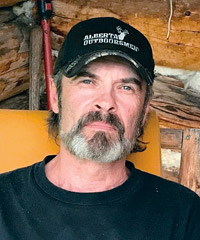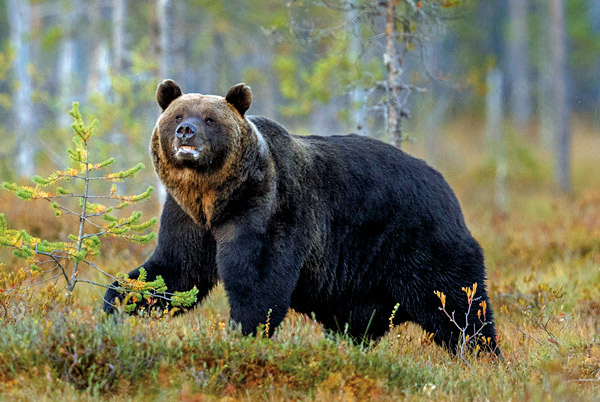Outdoor Pursuits

with Rob Miskosky
From the Editor - August 2024

photo - iStock.com/Photocech
Way back in 2006, Alberta banned the hunting of grizzly bears and later, in 2010, the great bear was listed as a threatened species. At that time, it was suggested—depending on which crowd you listened to—there were fewer than 600 grizzly bears left in the province, and many claimed that number to be high. But according to the Government of Alberta’s 2020 grizzly bear recovery plan, the grizzly bear population was estimated to be more than 850 bears on provincial lands back in 2004, two years before the hunt was suspended. It was suggested at that time that less than 1000 bears in the province meant recovery actions needed to take place; hence, a ban on the hunt.
Today, it is estimated that the number of grizzly bears in Alberta could be as high as 1150. While that number might be disputed by some, one thing that has to be agreed upon is that the great bear is recovering and expanding its range. This is proven by the fact that negative interactions between humans and grizzlies, as well as interactions between grizzlies and livestock have increased quite dramatically, as the bears move into populated rural areas. In the last three years alone, four Albertans have been killed by grizzly bears.
Emotions always run high when the discussion turns to grizzly bears in Alberta, especially when a hunt of the great bear is mentioned, which is what the GoA announced on July 9. Well, not exactly a hunt; rather, how problem bears are going to be removed. Now, I’m not going to go into all of the details of how this came about (you can read a lot more from Brad Fenson on page 12 and Brian Bildson on page 46) but just know that Minister Loewen is allowing the removal of problem bears by what are going to be called “Wildlife Management Responders”, essentially hunters that might decide to sign up for the job.
In a recent interview with the Western Standard, Minister Loewen, the man in charge of Alberta’s wildlife said, “There’s a matrix that fish and wildlife officers use when they have problem wildlife and that matrix will stay the same as it has been for decades. We’ve had fish and wildlife officers and conservation officers killing grizzlies ever since the hunt ended in 2006, and this is just an opportunity for Albertans to be involved to help with that process so fish and wildlife officers can spend their time doing other things, because it is timely when you have a negative incidence.”
In a podcast interview with Real Talk host Ryan Jesperson, John Marriott, grizzly bear saviour and “donate” button holder claims, “If they’re going to have these wildlife management responders, this ridiculous term that is really basically hitmen, hunters that are going to be hired by the government, untrained people that are going to go out and respond, they’re going to be wildlife vigilantes. “Minster Loewen was very clear that this is not a hunting opportunity and he’s absolutely right, it’s a killing opportunity, so his buddies can go out and kill grizzly bears.”
Tell us how you really feel, John.
Responders will be limited to Alberta residents only and according to Loewen, “There’s going to be a lot of conditions, they’re just not going to be turned loose and be able to do what they want.”
Hunting and Fishing Branch, Executive Director, Matt Besko, laid out the criteria to become a responder, “...one must be a resident of Alberta, age 18 or older at the time of application, must have held a hunting licence in 2023, and be eligible to hold a hunting licence for 2024.”
Rob Corrigan, Manager of Licensing for the Hunting and Fishing Branch explained, “Alberta residents who have held a wildlife certificate in Alberta in either 2022 or 2023 were sent an email outlining this program. Individuals who are interested in participating were then able to apply through a link contained in the information email.
“From the list of applicants, a randomly selected short list of applicants will be created. Individuals who are randomly selected for the short list will be screened to ensure they meet the criteria outlined for participating in the program.
“The list of verified applicants will then be notified that they are included on the short list of participants and will then be made available to program staff to be used if a wildlife responder is to be utilized.”
At the end of the day, whether or not a wildlife responder will be called in will be entirely up to the Fish and Wildlife officer at the scene. Now, I’m not going to confess that I know the thoughts of Fish and Wildlife officers regarding responders, but I would suggest that if there’s an instance where a human life has been taken or a person has been seriously injured by a grizzly bear, the Fish and Wildlife officer at the scene won’t be calling in for a responder; he or she will be taking action themselves—I would bet on it.
However, in the case of a grizzly killing livestock, perhaps an officer won’t have the time to spend waiting on that bear, this is when I see a responder being called... but maybe not; again, it’s up to the officer.
I would offer that there will be very few instances of a responder being called in to kill a problem bear, so those with their hair-on-fire should probably relax a little—the grizzly bear hunt is NOT back on!
For the previous Outdoor Pursuits article, click here.



